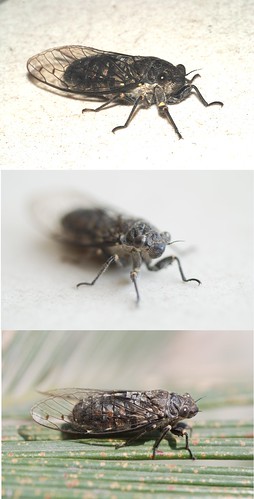Now then - an excuse to ramble about bugs, and also say a bit about insect photography. How could I resist?
The cicadas are just coming out in the warm weather here, and already are starting to make a real racket. They're gorgeous insects, about 2 cm up to at least 5 cm long, and closely related to greenfly and leafhoppers. There's maybe one species in the UK - a small, shy species that lived until recently in the New Forest. Alas, it may well now be extinct.
It's often hard to be sure with cicadas, though, because they have a multi-year life cycle. Some stay as nymphs for nearly twenty years, feeding on tree roots underground, and only emerging (often en masse) as an adult for a few brief weeks - at which point they promptly climb the highest tree they can find, and start scraping their legs against their wings. As a result, cicadas are much more commonly heard than seen. A traditional children's game in China is catching cicadas in the first weeks of summer, using a long pole with sticky stuff on the end. They then put them in cages, hang them outside their windows, and have competitions to see who can deafen the most neighbours with the fewest bugs. At least, that's the way it apparently used to be - we'll have to see if it happens this year.
This one took pity on me, and was waiting for us in the lobby of apartment block this morning. A small one, about 2 cm long, it was very friendly, and was delighted to cling onto my finger as I tried to transplant it to the cycads outside.
Taking photographs of insects can be a bit tricky if you don't know where to start, and you can get completely different results from different settings on you camera. These three pictures are taken with the same camera, minutes apart, and give you an idea of the different effects you can get from one that lets you fiddle with settings...
Top picture: flash, indoors, with subsequent processing of brightness and contrast. The colours are difficult to see, and many features are very "hard" - it's a very harsh lighting effect, although often essential if you're looking at tiny insects rather than things a couple of centimetres long, as here.
The middle photo was taken indoors in quite good ambient light. In order to get a sensible exposure time (to avoid camera shake), the aperture is wide open. The result is a very limited depth of field, hence all the blurring in the background (exacerbated by the oblique view of course!).
Finally, the last was taken outside, in strong sunlight, with no flash. The ambient light level was high enough to allow a part-closed aperture, hence a decent depth of field, and the colours are pretty much true. This is by far the preferred method if you're dealing with big things, and it's worth putting the ISO up a bit if necessary to get a manageable exposure time. Sadly, I normally do tiny things, where flash, glare and non-true colours start to become a problem.
Still, I'm sure there will plenty of bigger beasties to keep us occupied this year!
Tuesday, 19 April 2011
Photographing cicadas
Subscribe to:
Post Comments (Atom)


No comments:
Post a Comment